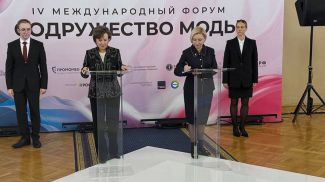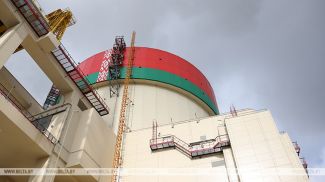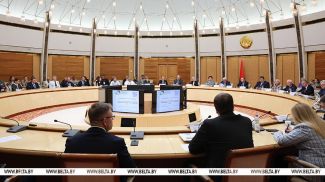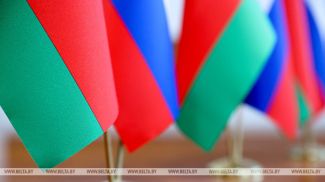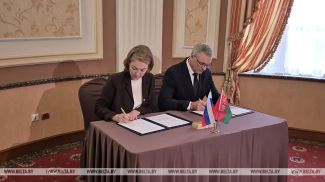
MINSK, 30 October (BelTA) – At a meeting of a working group to fine tune the draft program of socio-economic development until 2030, Chairman of the Board of the National Bank of Belarus and head of the group Roman Golovchenko revealed how the project was refined on the instructions of the president, BelTA has learned.
Roman Golovchenko stressed that, in accordance with the president’s instructions, the working group refined the draft program of socio-economic development of the Republic of Belarus for 2026-2030. “As a result, we believe the revised draft program, first, complies with legislative requirements in the field of state planning and national development forecasting. Second, it conveys to the delegates of the Belarusian People’s Congress a clear vision of the country’s key development priorities. Third, it incorporates the principles of validity, measurability, and feasibility in setting goals and objectives. Fourth, it reflects the constructive proposals of Congress’s delegates who contributed to the drafting process, as well as input from the public within the framework of the nationwide People’s Five‑Year Plan project,” he said.
Eight strategic, comprehensive priorities have been identified, each accompanied by specific tasks, mechanisms, and performance indicators. “These priorities are closely aligned with the National Sustainable Development Strategy through 2040, the president’s election program, and other programmatic speeches and statements by the head of state regarding the upcoming five-year period. They also chart the course for the country’s systemic development, aimed at achieving the central goal of the plan – a new quality of life for every Belarusian,” the head of the National Bank emphasized.
Roman Golovchenko added that in the revised draft, the lists of tasks had been optimized. “Traditional tasks, procedural tasks, routine work, as well as formal, low-informative, and insufficiently demanding indicators, which often do not fully reflect the implementation of priorities and objectives, have been excluded from the program. This approach, which also takes into account the limited volume of available funding, makes it possible to focus efforts on truly important areas of socio-economic development and to avoid the dilution of resources,” he emphasized.
Taking into account the rational proposals of the delegates of the Belarusian People’s Congress and the public, the draft program has been supplemented with a number of new high-level tasks, including those identified by members of the working group in the course of their individual work. “They are primarily related to the innovative development of the country: improving efficiency, quality, investment, knowledge intensity, innovation, and technological advancement of the economy; enhancing the practice-oriented nature of education; creating conditions for the realization of young people’s creative potential; and fostering the patriotic upbringing of the younger generation,” the head of the National Bank stated.
With the introduction of new tasks, the quantitative indicators have also been revised. The draft program has been supplemented with indicators related to birth rates, youth involvement in socio-political and managerial activities, and expanding opportunities for older citizens to realize their potential.
The main forecast indicators and the list of major investment projects in industry have also been expanded, including projects related to advanced processing, the production of new materials, and innovative technologies.
“The tasks and indicators defined in the draft program will in many respects require significant personnel effort and resource mobilization. But this is our conscious choice, because focusing only on ‘balanced growth’ will not reduce the technological and demographic gap with leading economies, nor will it encourage government bodies to seek effective models of accelerated development,” the head of the working group stressed.
Roman Golovchenko noted that the draft program revised by the working group has a clearly structured framework. “Priorities, directions, and tasks are consistent. The main part contains specific goals and indicators of their achievement, which are then broken down and detailed in sectoral and regional programs,” he concluded.
Roman Golovchenko stressed that, in accordance with the president’s instructions, the working group refined the draft program of socio-economic development of the Republic of Belarus for 2026-2030. “As a result, we believe the revised draft program, first, complies with legislative requirements in the field of state planning and national development forecasting. Second, it conveys to the delegates of the Belarusian People’s Congress a clear vision of the country’s key development priorities. Third, it incorporates the principles of validity, measurability, and feasibility in setting goals and objectives. Fourth, it reflects the constructive proposals of Congress’s delegates who contributed to the drafting process, as well as input from the public within the framework of the nationwide People’s Five‑Year Plan project,” he said.
Eight strategic, comprehensive priorities have been identified, each accompanied by specific tasks, mechanisms, and performance indicators. “These priorities are closely aligned with the National Sustainable Development Strategy through 2040, the president’s election program, and other programmatic speeches and statements by the head of state regarding the upcoming five-year period. They also chart the course for the country’s systemic development, aimed at achieving the central goal of the plan – a new quality of life for every Belarusian,” the head of the National Bank emphasized.
Roman Golovchenko added that in the revised draft, the lists of tasks had been optimized. “Traditional tasks, procedural tasks, routine work, as well as formal, low-informative, and insufficiently demanding indicators, which often do not fully reflect the implementation of priorities and objectives, have been excluded from the program. This approach, which also takes into account the limited volume of available funding, makes it possible to focus efforts on truly important areas of socio-economic development and to avoid the dilution of resources,” he emphasized.
Taking into account the rational proposals of the delegates of the Belarusian People’s Congress and the public, the draft program has been supplemented with a number of new high-level tasks, including those identified by members of the working group in the course of their individual work. “They are primarily related to the innovative development of the country: improving efficiency, quality, investment, knowledge intensity, innovation, and technological advancement of the economy; enhancing the practice-oriented nature of education; creating conditions for the realization of young people’s creative potential; and fostering the patriotic upbringing of the younger generation,” the head of the National Bank stated.
With the introduction of new tasks, the quantitative indicators have also been revised. The draft program has been supplemented with indicators related to birth rates, youth involvement in socio-political and managerial activities, and expanding opportunities for older citizens to realize their potential.
The main forecast indicators and the list of major investment projects in industry have also been expanded, including projects related to advanced processing, the production of new materials, and innovative technologies.
“The tasks and indicators defined in the draft program will in many respects require significant personnel effort and resource mobilization. But this is our conscious choice, because focusing only on ‘balanced growth’ will not reduce the technological and demographic gap with leading economies, nor will it encourage government bodies to seek effective models of accelerated development,” the head of the working group stressed.
Roman Golovchenko noted that the draft program revised by the working group has a clearly structured framework. “Priorities, directions, and tasks are consistent. The main part contains specific goals and indicators of their achievement, which are then broken down and detailed in sectoral and regional programs,” he concluded.





